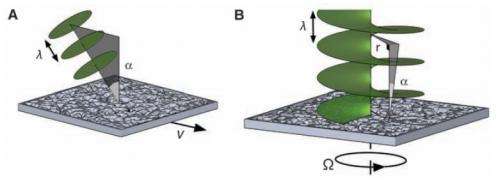August 2, 2013 report
Researchers find way to measure speed of spinning object using light's orbital angular momentum

(Phys.org) —Researchers in Scotland have devised a way to use the Doppler Effect to discern the spin speed of a rotating object where the object is directly facing the light source. In their paper published in the journal Science, the team describes lab experiments they conducted that allowed them to observe a frequency shift proportional to the product of the rotation frequency of an object and the orbital angular momentum of the light.
Most everyone is familiar with the Doppler Effect—it's what makes the sound of sirens change in pitch as they pass by. Scientists have been using this phenomenon in various ways for years to learn more about the world around us—one application was determining that most observable stars and galaxies are moving away from us, which led to the theory of the expansion of the universe. Scientists have also learned over the years that the Doppler Effect can be applied to rotating objects as well so long as the light source is not aligned with the axis of rotation–light waves reflected off turbo blades, for example, are different depending on if they are moving towards or away from the source.
In this new effort, the researchers found a way to measure the spin speed of an object that is not observed at an angle by taking advantage of a characteristic of light known as orbital angular momentum (OAM). This is where electromagnetic energy associated with light flows forward in the direction of propagation while also continuously moving around its own axis. In essence, it's light moving through space like a corkscrew. The researchers found that light can be imbued with OAM if it is reflected off a rotating object and it was this discovery that led to its use in calculating the spin speed of the object. Specifically, they found they could calculate the spin speed of the object by measuring the OAM in the light that has been reflected back by it.
To test their theory, the researchers fired a laser at a spinning plate in their lab then used a light detector to measure the degree of OAM. Because the plate was spinning, it gave off both positive and negative OAM—the degree of difference between the two gave the researchers the speed of rotation of the object.
Because the new method allows for determining spin speed head-on and from a distance, it might be used to determine the spin speed of planets, or back here on Earth to fine tune wind turbines.
More information: Detection of a Spinning Object Using Light's Orbital Angular Momentum, Science 2 August 2013: Vol. 341 no. 6145 pp. 537-540 DOI: 10.1126/science.1239936
ABSTRACT
The linear Doppler shift is widely used to infer the velocity of approaching objects, but this shift does not detect rotation. By analyzing the orbital angular momentum of the light scattered from a spinning object, we observed a frequency shift proportional to product of the rotation frequency of the object and the orbital angular momentum of the light. This rotational frequency shift was still present when the angular momentum vector was parallel to the observation direction. The multiplicative enhancement of the frequency shift may have applications for the remote detection of rotating bodies in both terrestrial and astronomical settings.
Journal information: Science
© 2013 Phys.org





















